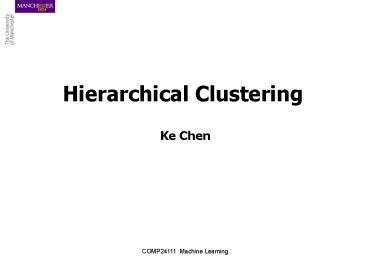Hierarchical Clustering - PowerPoint PPT Presentation
1 / 21
Title:
Hierarchical Clustering
Description:
Hierarchical Clustering Ke Chen COMP24111 Machine Learning COMP24111 Machine Learning * Outline Introduction Cluster Distance Measures Agglomerative Algorithm Example ... – PowerPoint PPT presentation
Number of Views:153
Avg rating:3.0/5.0
Title: Hierarchical Clustering
1
Hierarchical Clustering
- Ke Chen
COMP24111 Machine Learning
2
Outline
- Introduction
- Cluster Distance Measures
- Agglomerative Algorithm
- Example and Demo
- Relevant Issues
- Summary
3
Introduction
- Hierarchical Clustering Approach
- A typical clustering analysis approach via
partitioning data set sequentially - Construct nested partitions layer by layer via
grouping objects into a tree of clusters
(without the need to know the number of clusters
in advance) - Use (generalised) distance matrix as clustering
criteria - Agglomerative vs. Divisive
- Two sequential clustering strategies for
constructing a tree of clusters - Agglomerative a bottom-up strategy
- Initially each data object is in its own (atomic)
cluster - Then merge these atomic clusters into larger and
larger clusters - Divisive a top-down strategy
- Initially all objects are in one single cluster
- Then the cluster is subdivided into smaller and
smaller clusters
4
Introduction
- Illustrative Example
- Agglomerative and divisive clustering on the data
set a, b, c, d ,e
5
Cluster Distance Measures
- Single link smallest distance between an
element in one cluster and an element in the
other, i.e., d(Ci, Cj) mind(xip, xjq) - Complete link largest distance between an
element in one cluster and an element in the
other, i.e., d(Ci, Cj) maxd(xip, xjq) - Average avg distance between elements in one
cluster and elements in the other, i.e., - d(Ci, Cj) avgd(xip, xjq)
d(C, C)0
6
Cluster Distance Measures
- Example Given a data set of five objects
characterised by a single feature, assume that
there are two clusters C1 a, b and C2 c, d,
e. - 1. Calculate the distance matrix. 2.
Calculate three cluster distances between C1 and
C2.
a b c d e
Feature 1 2 4 5 6
Single link Complete link Average
a b c d e
a 0 1 3 4 5
b 1 0 2 3 4
c 3 2 0 1 2
d 4 3 1 0 1
e 5 4 2 1 0
7
Agglomerative Algorithm
- The Agglomerative algorithm is carried out in
three steps
- Convert all object features into a distance
matrix - Set each object as a cluster (thus if we have N
objects, we will have N clusters at the
beginning) - Repeat until number of cluster is one (or known
of clusters) - Merge two closest clusters
- Update distance matrix
8
Example
- Problem clustering analysis with agglomerative
algorithm
data matrix
Euclidean distance
distance matrix
9
Example
- Merge two closest clusters (iteration 1)
10
Example
- Update distance matrix (iteration 1)
11
Example
- Merge two closest clusters (iteration 2)
12
Example
- Update distance matrix (iteration 2)
13
Example
- Merge two closest clusters/update distance matrix
(iteration 3)
14
Example
- Merge two closest clusters/update distance matrix
(iteration 4)
15
Example
- Final result (meeting termination condition)
16
Example
- Dendrogram tree representation
- In the beginning we have 6
- clusters A, B, C, D, E and F
- We merge clusters D and F into
- cluster (D, F) at distance 0.50
- We merge cluster A and cluster B
- into (A, B) at distance 0.71
- We merge clusters E and (D, F)
- into ((D, F), E) at distance 1.00
- We merge clusters ((D, F), E) and C
- into (((D, F), E), C) at distance 1.41
- We merge clusters (((D, F), E), C)
- and (A, B) into ((((D, F), E), C), (A, B))
- at distance 2.50
- The last cluster contain all the objects,
- thus conclude the computation
17
Example
- Dendrogram tree representation clustering USA
states
18
Exercise
- Given a data set of five objects characterised by
a single feature - Apply the agglomerative algorithm with
single-link, complete-link and averaging cluster
distance measures to produce three dendrogram
trees, respectively.
a b C d e
Feature 1 2 4 5 6
a b c d e
a 0 1 3 4 5
b 1 0 2 3 4
c 3 2 0 1 2
d 4 3 1 0 1
e 5 4 2 1 0
19
Demo
Agglomerative Demo
20
Relevant Issues
- How to determine the number of clusters
- If the number of clusters known, termination
condition is given! - The K-cluster lifetime as the range of threshold
value on the dendrogram tree that leads to the
identification of K clusters - Heuristic rule cut a dendrogram tree with
maximum K-cluster life time
21
Summary
- Hierarchical algorithm is a sequential clustering
algorithm - Use distance matrix to construct a tree of
clusters (dendrogram) - Hierarchical representation without the need of
knowing of clusters (can set termination
condition with known of clusters) - Major weakness of agglomerative clustering
methods - Can never undo what was done previously
- Sensitive to cluster distance measures and
noise/outliers - Less efficient O (n2 ), where n is the number
of total objects - There are several variants to overcome its
weaknesses - BIRCH scalable to a large data set
- ROCK clustering categorical data
- CHAMELEON hierarchical clustering using dynamic
modelling
Online tutorial the hierarchical clustering
functions in Matlab
https//www.youtube.com/watch?vaYzjenNNOcc































